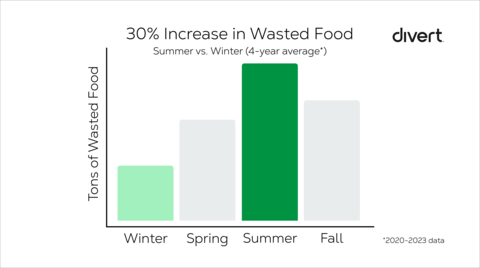Extreme heat and changing consumer behaviors are among the contributors to drastic surge in food waste during the summertime
Divert, Inc., an impact technology company on a mission to Protect the Value of Food™, released new data today demonstrating the scale of the wasted food crisis during the summer months. The company’s 2020-2023 data showed that wasted food measured nearly 30% higher in summertime than the winter months1.
This press release features multimedia. View the full release here: https://www.businesswire.com/news/home/20240731208196/en/

Divert's 2020-2023 data showed that wasted food measured nearly 30% higher in summertime than the winter months. (Graphic: Business Wire)
“While wasted food is truly a year-round crisis, our data indicates that the summer months are the leading source of food waste throughout the year. This increased volume stresses food donation networks since there is more perishable food to move, requiring backup infrastructure to be in place to accommodate these swings in material to avoid landfilling,” said Ryan Begin, CEO and co-founder of Divert. “Our findings demonstrate the importance of data in having visibility into this problem, but we must take it further to drive meaningful change. From here, we need real action and solution implementation with stakeholders across the industry - from consumers to retailers, food manufacturers to restaurants.”
Divert reviewed its 2020-2023 wasted food data from retail, food service, and industrial customers at certain operating facilities across the U.S. The company looked at the total food waste material collected each year, comparing the summer months of July, August, and September with the winter months of January, February, and March of the same calendar year. The average across the four-year period showed a marked increase (30%) in food waste during the summer.
Divert has identified several key factors among the contributors to the summertime increase, as well as solutions to address them:
-
Extreme heat driven by climate change.
The Earth recently saw its warmest two days since at least 1940 and last year was reported as the warmest year on record. As we experience more extreme heat brought on by climate change, the margin of error for mishandling food increases significantly. For example, a delivery of strawberries left on a retailer’s loading dock or in a truck for too long before being moved into a refrigerated area can cause it to lose freshness more quickly. The hotter it is outside, the less time retailers have to move food before it is no longer safe to consume.
As we navigate the new normal of extreme temperatures, it is more critical than ever to look to solutions that can enable increased visibility and provide actionable data throughout the supply chain.
-
Changing consumer behavior in the summer months.
The summer months are synonymous with fresh, high-quality produce available at grocery stores and a surge in consumers dining out at restaurants and bars. Grocers and restaurants are sourcing more food to meet the demand but are challenged to determine real-time and accurate forecasting and replenishment.
To better adapt to fluctuating consumer behaviors, technologies can be implemented that uncover key data and insights to better inform food retailers and restaurants.
-
Peak season for perishable food products.
Summer means more highly perishable food products, such as berries and stone fruit, are available. At the same time, stores are seeing increased sales and consumption for backyard barbeques and other gatherings. All of this leads to more volume through stores and, in turn, increased waste.
With overabundance or over-purchasing of food, improvements can be made to food donation programs or, in the case of grocery stores, marking down any soon-to-expire products for consumers.
For more information on how to take action to address the wasted food crisis - from the grocery shelf to the home - please visit www.divertinc.com.
About Divert, Inc.
Divert, Inc. is an impact technology company on a mission to Protect the Value of Food™. Founded in 2007, the company creates advanced technologies and sustainable infrastructure to eliminate wasted food, driving social and environmental impact. Divert provides an end-to-end solution that prevents waste by maximizing the freshness of food, recovers edible food to serve communities in need, and converts wasted food into renewable energy. The company works with over 6,600 customer locations across the U.S. to reduce wasted food and positively impact people and the environment. Its customer base spans across industries and includes five Fortune 100 companies. For more information on Divert, Inc., please visit www.divertinc.com.
1 Percentage calculated from total food waste material received at certain Divert U.S. operating facilities, comparing the total food waste material received in July, August, and September with January, February, and March of the same calendar year. The percentage represents the average difference across 2020-2023.
View source version on businesswire.com: https://www.businesswire.com/news/home/20240731208196/en/
Contacts
Divert Media Contact
Caroline Legg
Director of Public Relations
(203) 313-4228
clegg@divertinc.com













